DNS and rDNS: the Hidden Heroes That Keep the Internet Running
Discover the web's overlooked helpers - DNS & rDNS. Learn their importance, benefits, and automation's role in powering the online world.

The Internet is filled with unseen infrastructure that makes accessing resources seamlessly possible. While we mindlessly open our browsers and type in domain names daily, complex mechanics powering name and address mapping work tirelessly in the background. DNS and rDNS are the unsung heroes diligently operating to uphold the Internet’s functionality.
Key Takeaways
- DNS (Domain Name System) and rDNS (reverse DNS) are foundational technologies that quietly operate in the background, translating human-friendly domain names into machine-readable IP addresses.
- DNS is crucial for usability, connectivity, security, performance, reliability, and visibility on the internet. It simplifies web navigation, enhances security, and optimizes resource allocation, all while providing insights into usage patterns and issues. rDNS, on the other hand, plays a pivotal role in authentication, spam prevention, and identifying the origins of internet traffic.
- Innovations like automated rDNS and PTR record management, exemplified by IPXO, simplify complex administrative tasks related to DNS and rDNS. This automation not only saves time but also ensures that DNS and rDNS continue to underpin the modern Internet’s stable foundations.
DNS: Connecting the dots to domains
The Domain Name System (DNS) is such an ingrained part of Internet technology today that its importance is often taken for granted. Yet, it’s one of the most crucial components powering access to websites and other Internet resources that we depend on every day.
DNS acts as the “phonebook” of the Internet, translating human-readable domain names into IP addresses that computers can understand. It links the domain names we type like www.example.com to the numeric IP addresses that machines use to identify devices on a network. Without DNS mapping domains to IPs, using the internet as we know it simply wouldn’t be possible.
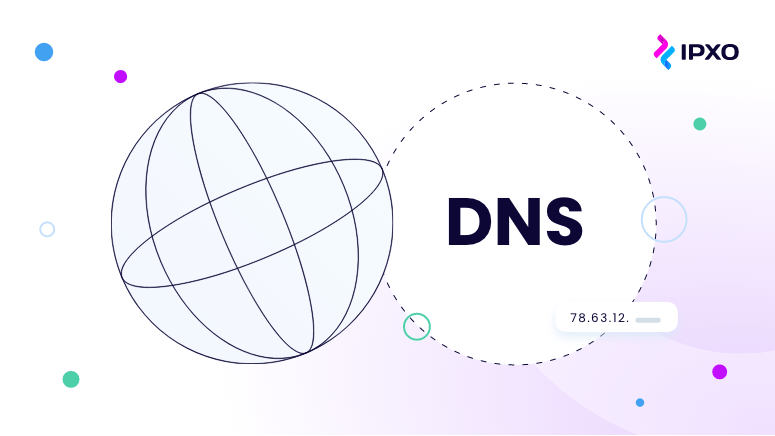
When you type a URL into your web browser, your device sends a request to a DNS resolver, which is typically provided by an Internet Service Provider (ISP). The DNS resolver then queries a DNS nameserver, which stores DNS records matching domains to IPs. The nameserver looks up the IP address for the requested domain name and returns it to the resolver and your browser.
For example, when you enter example.com into your browser address bar, the DNS system retrieves the IP 93.184.216.34 that is linked to that name in its records. Your browser can then seamlessly connect to 93.184.216.34, without you ever having to know that underlying IP address.
This behind-the-scenes IP address lookup performed by DNS servers is what keeps the Internet experience smooth and user-friendly. You get to use convenient, human-readable domain names, while DNS handles the technical heavy lifting of resolving those names to the numeric IP addresses that computers rely on. Without DNS converting domains to machine-oriented IPs, the web as we know it today would cease to function.
DNS offers several key benefits that make the Internet usable:
- Human-readable names: Simplifies internet navigation by allowing easy-to-remember domain names instead of hard-to-memorize numeric IP addresses
- Load distribution: Distributes incoming traffic across multiple servers, improving website performance, speed, and reliability
- Redundancy and failover: Backup DNS records ensure traffic gets directed to alternate servers if one server fails, preventing total outages
- Global accessibility: Enables websites to be accessed globally via the same familiar domain name, regardless of user location
- Easy updates: Updating DNS records to point to new servers is simple and prevents changing IPs on every device
DNS traffic is also managed via caching and load balancing. Caching stores query results temporally, reducing lookup times for frequently visited domains. Load balancing shares traffic across servers to avoid overload. Together, redundancy, caching, and load balancing make DNS resilient and efficient.
The seamless functionality DNS provides is interwoven into internet technology. While often out of sight, DNS quietly toils away to grant users simple access to resources through memorable names rather than obscure number combinations.
What are the different types of DNS records?
A DNS record is an entry in the global DNS database that maps a specific domain name to an IP address or provides other information. There are different types of DNS records, each containing specialized data and serving particular purposes.
Each DNS record stores information like the record type, the time-to-live (TTL) value determining how long it gets cached by resolvers, and most importantly the resource that it points to.
Some of the most common DNS record types are:

- A record: Maps a domain name to an IPv4 address
- AAAA record: Maps a domain name to an IPv6 address
- CNAME record: Creates an alias or nickname for a domain name
- MX record: Specifies the mail servers responsible for handling email for a domain
- NS record: Defines the authoritative name servers for a domain
- PTR record: Used in reverse DNS to map IP addresses back to domain names
- TXT record: Stores text data like domain verification info for ownership validation
- SOA record: Contains admin contact and zone data like refresh times for a domain
Out of this list, we will delve deeper into the PTR record, but first, let’s clear up what reverse DNS is.
rDNS: The reverse lookup
While DNS handles directly mapping domains to IPs, reverse DNS (rDNS) does the opposite – resolves IP addresses back to domains. This reverse IP lookup provides crucial bidirectional binding, which is very important for security, spam prevention, and verifying the authenticity of emails.
Many email servers use rDNS to check if the sending server’s IP address matches its claimed domain, reducing the likelihood of spam or phishing emails.
Say a request comes into a server from IP 93.184.216.34. With DNS alone, determining the originating domain would be impossible. rDNS fills this gap by allowing the server to perform a reverse lookup, revealing the IP ties to www.example.com.
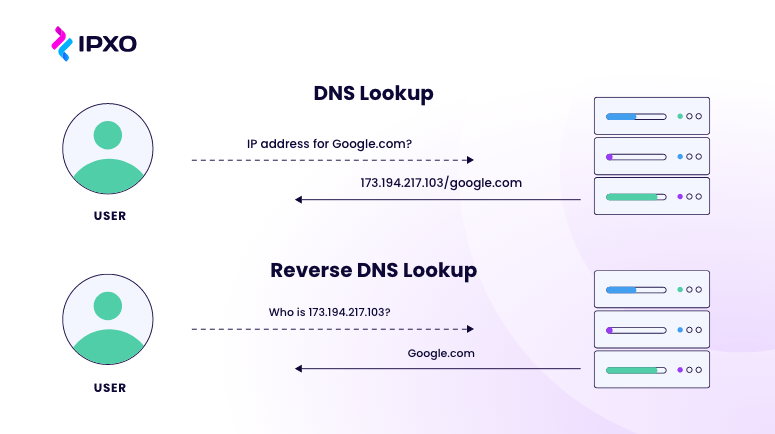
Why does this matter? rDNS offers servers a critical authentication mechanism. Servers can identify the domains making requests and allow or block them accordingly.
For instance, email services use rDNS to combat spam by verifying the legitimacy of sender domains. Web hosts can screen access requests through IP reverse lookups. rDNS acts as a line of defense against abuse like DDoS attacks by exposing the origins of suspicious traffic.
Bearing this in mind, IPXO strongly advises service providers to maintain vigilant oversight over their clients’ activities and take preemptive actions before any issues escalate. Moreover, we perform exclusive validation of domains within rDNS. This meticulous process serves to authenticate domain ownership and validate its absence from blocklists such as Spamhaus DBL.
The bidirectional mapping of DNS and rDNS is a codependent relationship enabling smooth name and address translations that power seamless internet usage. Like DNS, rDNS hums along continuously in the background, providing a fundamental layer of connectivity and security.
The importance of PTR records
An important type of DNS record for powering reverse DNS (rDNS) functionality is the PTR record.
PTR records map IP addresses to associated domain names, enabling reverse DNS lookups. They specifically allow translating an IP address back to a domain name, in contrast to normal “forward” DNS A records that map domains to IPs.
PTR records are a key component of rDNS. They facilitate servers identifying the actual domain that is making a request from a given IP address. This powers essential security protections, spam filters, email authentication, and more.
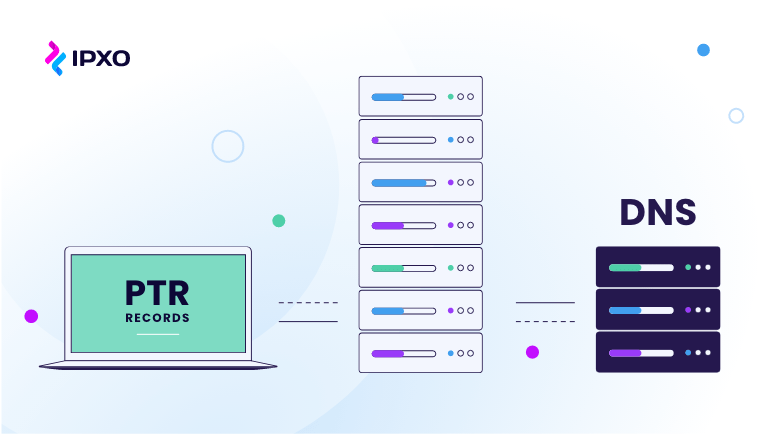
To set up reverse DNS records, you typically need to contact your ISP or the organization that manages your IP address range. They will configure the PTR records for your IP addresses, associating them with the corresponding domain names. This process helps ensure that your IP addresses have accurate rDNS entries.
Properly configuring PTR records is crucial to fully leverage the benefits of reverse DNS across an IP space. The new automated rDNS and PTR record management solutions from companies like IPXO greatly simplify this previously manual process.
Automated rDNS management: A game changer
Manually configuring and overseeing reverse DNS records for numerous IP addresses can be a laborious and time-intensive endeavor, particularly for those who obtain IP resources from Regional Internet Registries (RIRs). Recognizing this challenge, in May 2022, IPXO introduced an rDNS delegation automation feature to simplify and streamline this process for our clients.
With this innovative feature, IP lessees can seamlessly establish reverse DNS records through our platform. This automation involves setting up nameservers in the RIR for specific subnets, empowering clients to independently access and manage their PTR records.
What unfolded over the course of the year were remarkable transformations indeed. In response to the inherent risks associated with rDNS and its susceptibility to potential misuse, we have made a significant change in our approach. Moving forward, PTR and NS management will be whitelisted for our platform users.
This means that the rDNS feature will remain inactive until explicitly granted access to clients who have demonstrated their trustworthiness. This proactive measure ensures a higher level of security and control over rDNS capabilities, safeguarding the integrity of our services.

Furthermore, we fortified our system with additional validation mechanisms. When a client seeks to add a PTR record, our internal checks kick into action, cross-referencing the PTR record with its corresponding A record. Additionally, we rigorously assess the entry against the Spamhaus database DNS list, ensuring that the associated domain remains unblemished by blacklisting.
This level of automation empowers our clients to administer PTR records with ease, enabling them to swiftly view, add, edit, or delete their reverse DNS records without requiring manual intervention from IPXO staff. The automation of reverse DNS lookups translates into substantial time savings when compared to traditional manual rDNS configuration.
The hidden keepers of Internet functionality
Together, DNS and rDNS form the foundation that keeps access and navigation on the vast internet possible. While largely invisible, these technologies provide critical linking of human-friendly domains with machine-oriented IPs – the web’s true technical identifiers.
Some key reasons why DNS and rDNS matter:
- Usability – DNS allows convenient named access to resources instead of memorizing strings of numbers
- Connectivity – Bidirectional DNS/rDNS mappings connect users to content seamlessly
- Security – rDNS helps identify spoofed IPs and block suspicious traffic, whereas DNSSEC adds domain authentication
- Performance – Caching, redundancy, and load balancing makes DNS resilient and speedy
- Reliability – Distributed DNS servers prevent outages in name resolution
- Visibility – DNS traffic analytics provides crucial insights into usage patterns and issues
Conclusion
In conclusion, DNS and reverse DNS (rDNS) stand as foundational technologies that render the internet accessible and user-friendly. Gaining an understanding of their mechanics, benefits, and potential pitfalls is paramount for upholding a reliable online presence.
Through the implementation of best practices and robust security measures, you can ensure that your DNS and rDNS infrastructure contributes to optimal website performance and a secure digital environment.
The seamless functionality that DNS and rDNS provide is intricately woven into the fabric of the internet technologies and systems that underpin our contemporary world. While often invisible to the average user, DNS and rDNS work diligently behind the scenes, translating user-friendly domain names into the numeric IP addresses needed to access online resources.
Innovations like automated rDNS and PTR record management, developed by companies like IPXO, have simplified formerly intricate administrative tasks. Yet, the core value and significance of DNS and rDNS remain unwavering and universal. These unsung heroes steadfastly uphold the sturdy foundations of the modern internet.
Join us in shaping the future
FAQs about DNS & rDNS
DNS is primarily concerned with mapping domain names to IP addresses for easy navigation on the internet, while rDNS performs the reverse function, identifying domain names associated with IP addresses, which is vital for security and authentication purposes. Both DNS and rDNS are integral to the smooth and secure operation of the internet.
DNS is the backbone of the internet, facilitating human-friendly access to online resources, ensuring global accessibility, enhancing performance and reliability, and playing a vital role in security and authentication. Without DNS, the internet as we know it would be significantly less user-friendly and less secure.
DNS records are crucial components of the DNS system, serving to map human-readable domain names to machine-readable IP addresses and provide other resource-related information. Different types of DNS records fulfill specific purposes, such as directing web traffic, handling email, or verifying domain ownership. These records are fundamental to how the internet functions and ensure the seamless operation of online services and websites.
rDNS plays a vital role in email security, identifying the origins of internet traffic, preventing spam, enhancing network security, and verifying domain ownership. Its importance extends across various aspects of online communication and network management.
PTR records, short for “Pointer” records, are a type of Domain Name System (DNS) record used primarily in reverse DNS (rDNS) lookups. These records serve a crucial role in the internet’s infrastructure by mapping IP addresses to domain names, essentially performing the reverse of what traditional DNS records do. They are vital for email authentication, identifying the origins of internet traffic, and maintaining a secure and functional online environment.
About the author
Table of contents
DNS: Connecting the dots to domains
What are the different types of DNS records?
rDNS: The reverse lookup
The importance of PTR records
Automated rDNS management: A game changer
The hidden keepers of Internet functionality
Conclusion
FAQs about DNS & rDNS
Related reading
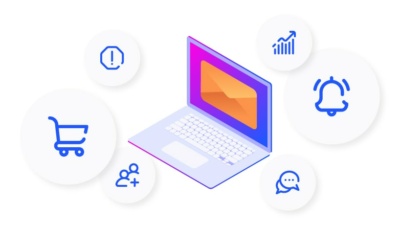
Email Service Provider: What You Should Know About ESPs in 2022
Discover the differences between email service providers and webmail clients. Learn the importance of ESPs for successful email marketing campaigns.
Read more
File Transfer Protocol Explained
What does FTP stand for? What is the importance of this protocol? How does it work? Read this post to learn all about the File Transfer Protocol.
Read more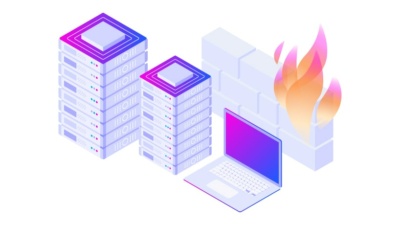
What Is a Firewall? A Guide to Cybersecurity
Learn all about firewalls, how they function, how they are configured and what different types of firewalls exist with this comprehensive guide.
Read moreSubscribe to the IPXO email and don’t miss any news!
